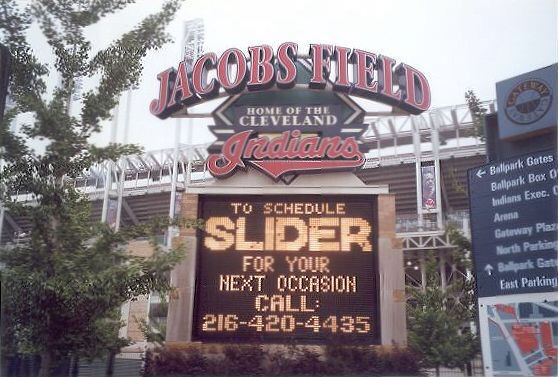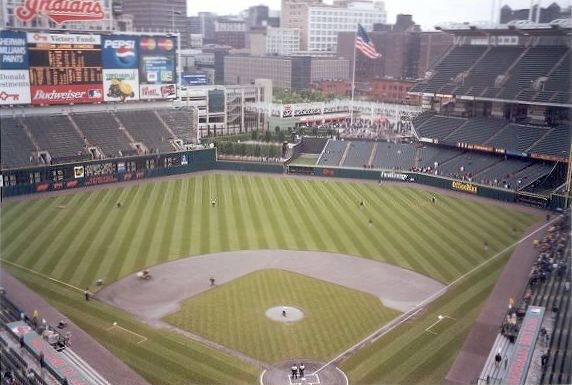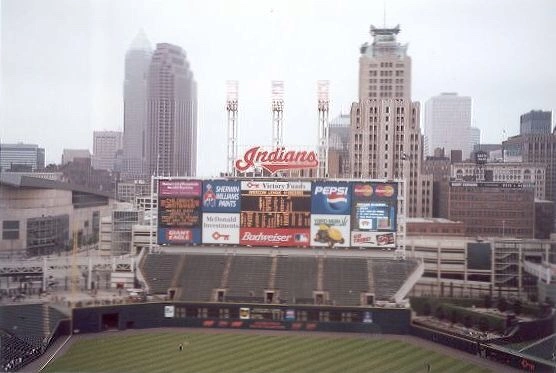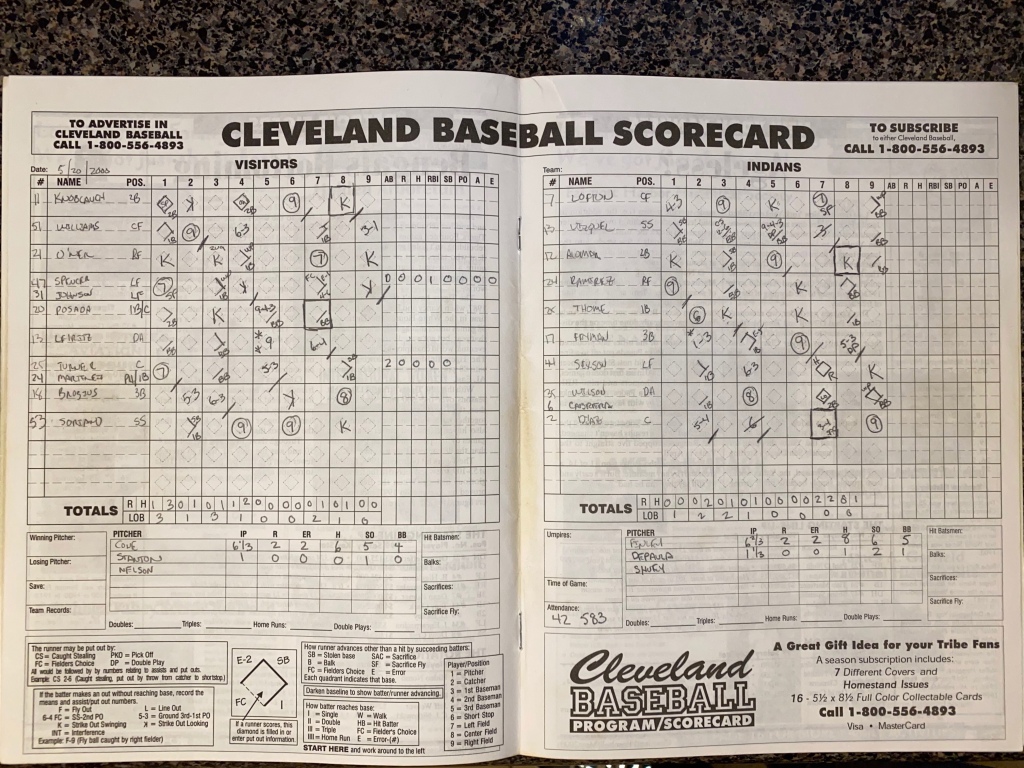
Our only baseball trip of 2000 took us to western PA and northeast OH in late May. Since the trip by car was in excess of five hours from central NJ, we drove out to northeast OH on Friday, May 19th, staying just outside of Cleveland for the night.
Saturday, May 20th dawned cloudy and chilly, much cooler than one might expect in late May across northeast OH. With a few hours before the 105 PM contest between the visiting New York Yankees and the hometown Indians, we decided to visit the Rock and Roll Hall of Fame, located adjacent to the southern shore of Lake Erie. Uncharacteristically, we visited the Hall without a camera, so we don’t have a visual record of our visit.
To my delight, the crowd at the Hall was thin, perhaps due to the weather and the relative early hour (as the doors opened at 1000 AM). As a result, we were treated to nearly unobstructed views of the myriad exhibits. Though we moved fairly quickly through the artifacts, we were able to appreciate the history of rock and roll (as well as pop music). Not surprisingly, the Beatles exhibit was the largest in the Hall, and our favorite band, Led Zeppelin, was well represented.
Not wanting to miss an opportunity to explore Jacobs Field, we left the Rock and Roll Hall of Fame after about 90 minutes. Even with the limited time spent there, we were impressed by the museum, and plan to return in the future for a better look. If you are a rock and roll fan, and plan to be in the vicinity of the Hall, leave yourself some time for a visit: you won’t be disappointed.
1. Jacobs Field
Venturing back out in the cool and breezy conditions, we completed the short drive from the Rock and Roll Hall of Fame to Jacobs Field. Had the weather been better, we might have walked the distance, but the cool and damp air ruled that out. We were able to secure parking just across the street from the ballpark in a private lot at a reasonable price.
We performed our typical tour around the outside of the park, but the weather curtailed our walk. Ducking inside the stadium at the home plate entrance, we were greeted by a nearly empty park. Once inside, we had access to the entire seated area, exploring while taking pictures. Unfortunately, the low overcast made the stadium appear drab, but the images capture the conditions on the cool and cloudy early afternoon perfectly.

Since both teams were playing well, tickets for the Saturday matinee were scarce, and our seats were located in the last row of the upper deck on the first base side of the field. Just before game time, temperatures hovered in the 40s, and the persistent breeze off the lake made it feel even colder. Despite an announced crowd of 42,000+, the unseasonably cool weather held the actual attendance far below that number.
Starting for the visiting New York Yankees was veteran right hander David Cone. Thus far in 2000, Cone was struggling (with an ERA over 5.50), though he was less than a season from his perfect game in 1999. On the mound for the Indians was left hander Chuck Finley, who was in his first campaign for the Tribe. Each team featured a potent offense, but the combination of good starting pitching and cool weather raised the specter on a low scoring contest.

New York scratched out a single run in the first inning against Finley, then tacked on another run in the fourth inning (with Yankee right fielder Paul O’Neill driving in the run with a single), giving the visitors a 2-0 lead. Meanwhile, David Cone kept the Cleveland bats at bay through the first six innings. Each pitcher worked deliberately, slowing their approaches with runners on base. In spite of the lack of scoring, the pace of the game was glacial, punctuated by the cold and damp conditions.
During the slow play, we were able to get a better feel for Jacobs Field. Dreary weather made the six year old stadium seem drab, with little contrast between the field and the slate gray overcast that seemingly encased it. Because of the conditions, Jacobs Field did not shine, and the lack of fans made the ballpark seem larger than it appeared on TV. Clearly we were not seeing the park at its best. Though the crowd was sparse, one of the more memorable parts of our visit was the persistent drumming in the left field stands. With a typical crowd, the drumming may not have been as noticeable, but with little else happening in the largely empty stadium, it echoed almost to the point of distraction.

Cleveland broke through against David Cone in the bottom of the seventh inning, as Richie Sexson led off the frame with a solo home run. Scoring another run in the seventh, the Indians tied the game, while simultaneously knocking the Yankees starter out of the game. Each bullpen then kept the game tied heading into the bottom of the ninth inning. Yankees Jeff Nelson surrendered four walks during the frame, forcing in the winning run with two outs to give the Indians a 3-2 victory.
Despite the low scoring affair, the nine inning contest took three hours and 38 minutes to complete, which seemed even longer in the cold and wind. We filed out Jacobs Field quickly, as we planned to attend a game at Three Rivers Stadium in Pittsburg that evening. Disappointed that we didn’t get to experience the ballpark in better weather, we would have to return in the future to get a better feel for the stadium and environs.

2. Three Rivers Stadium, Pittsburgh PA

Spending more time at Jacobs Field than expected, we were left with about two and one-half hours to get to Three Rivers Stadium in Pittsburgh. Though it would be tight, we were optimistic that, with light traffic, we would arrive before the first pitch at 710 PM. However, events would conspire to make arriving on time impossible. A bit more than an hour into the trip, we encountered thunderstorms that hampered our progress. As we got closer to Pittsburgh, traffic slowed to a crawl.
Finally, we reached the parking lot next to the ballpark, located on the north shore of the Allegheny River (north of downtown Pittsburgh). Arriving well after the first pitch, we parked in a dark area under an overpass of Interstate 385. While there were plenty of fans in the area, it seemed fairly remote, and I had an uneasy feeling about leaving the car there.
Because we arrived in the second inning, we had no time to wander and explore as we normally would at a new stadium. Instead, we rushed to our seats to enjoy the game. As we travelled from Cleveland to Pittsburgh, we went from early spring weather to early summer weather, as very warm and humid conditions greeting us at Three Rivers Stadium. While there were storms in the area, they managed to avoid us during the game.
Unfortunately, we did not take pictures at the stadium, as we left the camera in the car in our haste. Three Rivers Stadium was a typical multipurpose stadium, nearly identical to Veterans Stadium in Philadelphia. This season would be the last for the Pirates at this ballpark, and its condition seemed to reflect that fact. However, it was a pleasant place to see a Saturday night ballgame.
Pittsburgh hosted the St Louis Cardinals, who scored early and often. St Louis scored six runs in the first four innings, the scored 13 runs in the last three frames, on the way to a 19-4 drubbing of the hometown Pirates. With the game out of hand for the Pirates, they sent catcher Keith Osik to the mound to pitch the top of the ninth inning. As might have been expected, Osik fared poorly, surrendering five runs on five hits. This outing marked Osik’s second MLB pitching performance. In 1999, he also pitched an inning during a blow out, and his performance then was only slight better than this night.
Even with the high scoring, the game took less than three hours, a stark contrast to the affair in Cleveland. Fortunately, my car was still there following the game, and because of the late game finish, we stayed at nearby a nearby hotel, driving home Sunday morning.















































